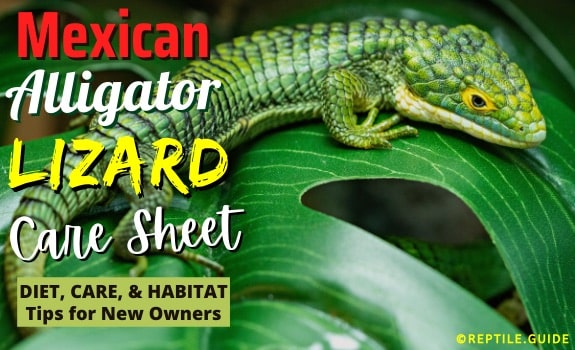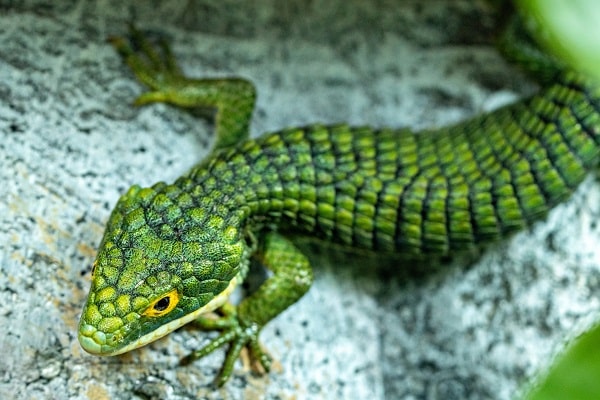While Mexican Alligator Lizards have only recently blossomed in popularity over the past ten or so years, these brilliant emerald green lizards have been featured on the cover of many popular reptile magazines and herpetofauna literature for decades.
Whether you’re drawn to their small size, unique habitat, brilliant coloration, or prehistoric-appearing keeled scales, it’s essential to understand that Mexican Alligator Lizards are not a low-maintenance pet for a novice.
This species requires a thorough understanding of their requirements and a commitment of time and money to set up a proper habitat, but we like to think the reward of a healthy Abronia lizard is well worth the work.
Keep reading to find out if you feel the same!
In This Article
Mexican Alligator Species Overview
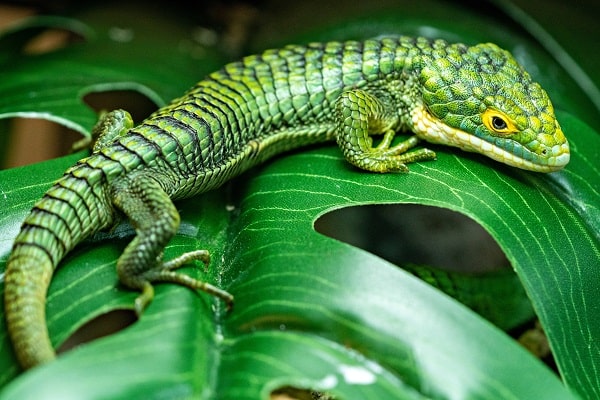
The Mexican Alligator Lizard is a small, arboreal lizard native to the Sierra Madre Oriental highlands of southern Mexico.
Their native habitats are mainly cloud forests, which are moist, subtropical forests with low-level cloud cover. Since these arboreal lizards inhabit the canopies, they literally live their life in the clouds!
Cloud forests feature high humidity, cool temperatures, drastic day and night temperature changes, and lots of moss.
Mexican Alligator Lizards are endangered and thus illegal to collect from the wild.
Their population is threatened by an illegal pet trade, deforestation, and wildfires. Because of this, it’s imperative that you obtain your captive-bred Mexican Alligator Lizard from a reputable breeder.
Many illegal importers and flippers will label their animals as captive-bred when they were, in fact, poached from the wild.
Appearance & Colors
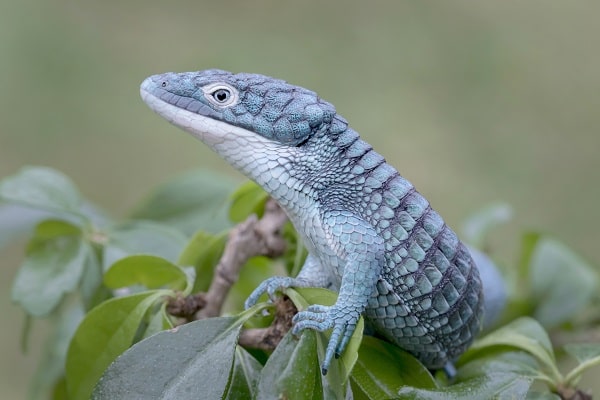
The Mexican Alligator Lizard’s unique appearance is its main draw amongst captive keepers.
Juvenile Mexican Alligator Lizards are a more drab, brownish tan color, with numerous black crossbands on the body and tail. Some adult females retain faint markings.
The scales on the animal’s back are keeled, giving its skin a rough texture.
Their head is triangular with rigid, armor-like plates for scales.
Those features give them their miniature alligator-like appearance and namesake.
Being arboreal, Mexican Alligator Lizards have long, prehensile tails and strong limbs and toes for gripping onto vegetation and branches.
Like many lizards, Mexican Alligator Lizards are capable of regrowing their tail if they lose it.
Mexican Alligator Lizard Size
Adult Length: 6-12”
Adult Weight: 21 Grams
Mexican Alligator Lizards are a relatively small species.
Males and females are usually around the same length, but males tend to weigh slightly more and have larger heads than females.
Neonate Mexican Alligator Lizards are tiny at around 4 inches long and as thick as an adult pinky finger.
They typically reach maturity at about 2 to 3 years of age.
Lifespan
Average Lifespan: 10-20 Years
Since not much is known about this species, and it has only recently become popular in captivity, no one is exactly sure of the “average” lifespan for a captive Mexican Alligator Lizard.
Based on limited evidence, it seems that they probably have an average lifespan between 10 and 20 years in captivity.
| Quick Facts at a Glance: | |
|---|---|
| Common name | Mexican Alligator Lizard, Arboreal Alligator Lizard |
| Scientific name | Abronia graminea |
| Adult size | 6-12 inches |
| Price | $100-$200+ |
| Lifespan | 10-20 years |
| Diet | Insectivore |
| Tank Size | 20” Long x 20” Wide x 30” Tall |
| Temperature & Humidity | Basking spot: 78-82°F, Ambient: 75-80°F, Nighttime drop: 50-72°F, Humidity: 60-80% |
| Popular alternatives | Red Eyed Crocodile Skink |
Mexican Alligator Lizard Care
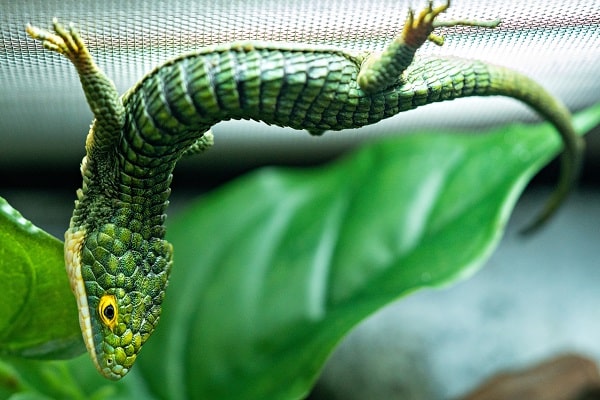
Most keepers would agree that the Abronia lizards require an “intermediate” or “advanced” level of care compared to other more commonly-kept pet lizards.
Even though they require stringent habitat parameters, once you’ve got their care dialed in and a routine established, they are a very hardy, healthy, and beautiful species to keep.
One crucial factor to consider is that you likely will not receive the reward of a cuddly, people-loving lizard for the efforts you put in.
If you’re looking for a reptile that you can handle daily, consider a bearded dragon or a corn snake.
Enclosure Size & Dimensions
Given their diminutive size, Mexican Alligator Lizards certainly don’t require large and expansive enclosures – but they are active hunters that will utilize as much space as you’re able to provide to them.
Being arboreal, the enclosure’s height is much more imperative than the floor space.
Minimum Adult Enclosure Size: 20” Long x 20” Wide x 30” Tall
Even young Abronia lizards can and probably should be housed in a similar-sized enclosure to ensure that you have the space required to provide a temperature, humidity, and lighting gradient.
Habitat Setup
Type of Enclosure
The best material to use for the construction of the cage is frequently debated amongst Mexican Alligator Lizard hobbyists.
Screen or mesh enclosures allow for adequate ventilation, which is imperative when you’re dealing with the high humidity that Abronias need to thrive.
A stagnant, moist habitat is a breeding ground for harmful organisms.
On the other hand, keepers living in arid climates argue that glass enclosures are required to maintain those high humidity levels.
In any case, if you are using a solid-sided enclosure, it’s highly recommended that you install electric fans to increase the airflow in the habitat. This is required to keep your lizard healthy!
Substrate
The most important duty that your substrate must fulfill is to maintain a high level of humidity in the enclosure.
Wild Mexican Alligator Lizards are often found burrowed into moss beds, so many keepers use sphagnum moss or orchid moss as the base of their substrate.
Other suitable substrate options for Mexican Alligator Lizards include:
- Organic potting soil
- Coconut fiber
- Peat moss
- Cypress mulch
- Washed play sand
- Spanish moss
- Leaf litter
These bedding materials create opportunities for your Abronia to find pockets of increased humidity or cooler temperatures, depending on its current biological needs.
Decor
Being arboreal, Mexican Alligator Lizards need a habitat equipped with natural or artificial branches or vines for climbing.
Try to fill and utilize as much of the vertical space as you can.
Abronias can often be found sleeping in tree hollows in the wild, so you might consider adding an elevated cork round or some other mounted or hanging arboreal hiding spot.
Plants
Epiphytic plants, also known as “air plants,” play an integral role in a wild Mexican Alligator Lizard’s life.
Abronias use bromeliads, orchids, ferns, and moss as microhabitats for increased humidity, water, shelter, and prey.
Mexican Alligator Lizards survive on water droplets and insects that are naturally attracted to air plants.
Because of this, most owners opt to keep their lizards in planted terrariums.
Since bromeliads and orchids don’t require soil to grow, they’re pretty simple to set up.
They can be tied to habitat decor and only require the same conditions you need to provide for your Abronia anyway: UVB lighting and high humidity.
Temperature & Lighting
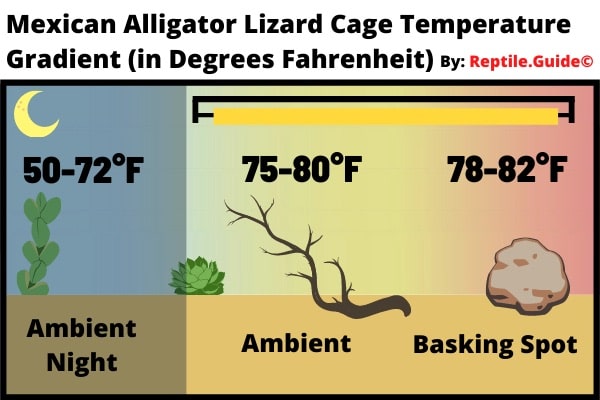
Mexican Alligator Lizards prefer cooler temperatures and are more susceptible to overheating if anything.
Most keepers find that the minor amount of heat put off by their UV lighting system is enough to provide a “basking spot” for the Abronias.
Otherwise, a very low-wattage heat bulb may be used during the day and turned off at night to allow for a night-time temperature drop.
| Temperature & Lighting Summary | |
|---|---|
| Basking Spot Temperature: | 78-82°F |
| Ambient Temperature: | 75°F-80°F |
| Night-time Ambient Drop: | 50°F-72°F |
Lighting, on the other hand, is essential for Mexican Alligator Lizards.
Abronia lizards offered no UVB lighting will eventually turn a drab, greenish-gray with a white chin and eye circles.
Most hobbyists allow their pet lizards to bask outside, in screen enclosures, so long as the temperature and climate are suitable.
As long as the sun is out and the temperature is above 55°F and under 90°F, you can move your Abronia’s mesh enclosure outside so it can bask in natural sunlight.
Deep, damp substrate and plenty of shady, leafy areas will ensure that your Mexican Alligator Lizard doesn’t overheat in the sun.
If and when you don’t have the option to move the enclosure outdoors, use compact or tube fluorescent light bulbs that give off 7-10% UVB for 12 hours per day.
Humidity and Water
Along with lighting, humidity is the second factor that’s imperative to your Abronia lizard’s health and wellbeing.
In fact, dehydration is thought to be the number one cause of captive Mexican Alligator Lizard deaths, and it’s caused by inadequate misting and humidity levels.
Ideal Humidity Level: 60-80%
While these animals require high humidity, they inhabit cloud forests, not swamps, so ventilation and fresh moisture are equally important.
In fact, you should periodically reduce misting to allow their substrate to dry out completely. This will prevent mold and bacteria growth. Never let it stay completely dry for longer than a day or two.
Their habitat should be misted heavily at least twice a day.
After misting, water droplets should be visible on the branches, leaves, and sides of the enclosure. This is how Abronias obtain their fluids – they won’t drink from a water dish.
In fact, many Abronias are most active when their enclosure is being misted, so this can create an excellent opportunity to bond with and check on your pet.
Most keepers invest in a dripping, misting, or fogger system due to the labor and time-intensive nature of their humidity and hydration requirements.
Preferably, you will treat the misting water with an aquarium conditioner to remove harmful chemicals or allow it to sit for 24 hours so those substances can dissipate.
Food & Diet
Mexican Alligator Lizards are entirely insectivorous.
They’re active hunters and aren’t very picky about the type of insects that they’re hunting.
Low-protein, low-fat, and high-calcium insects are the best choice when feeding your Mexican Alligator Lizard.
The following are all excellent food sources for your Abronia Lizard:
- Crickets
- Grasshoppers
- Caterpillars (hornworms)
- Snails
- Spiders
- Larvae (mealworms, black soldier fly larvae)
- Roaches
When possible, gut-load your feeder insects with calcium-rich leafy greens and fruits for 24 hours before feeding. The healthy vitamins and minerals from fresh plants will be absorbed and utilized by your lizard.
Dust the insects with a calcium powder every other feeding and with a reptile multivitamin once a week.
Feed adult Abronias 3 times per week.
Gravid females will stop eating about a month before giving birth (March-June). Most males will eat considerably less during the breeding season (September-December).
All Mexican Alligator Lizards have a reduced appetite during the Winter when temperatures are usually cooler.
Considerations for Young Mexican Alligator Lizards
Young Mexican Alligator Lizards are incredibly fragile and sensitive to husbandry mistakes.
Ensure there are no small gaps in their enclosure where they (or their food!) could escape.
Newborn babies start off eating fruit flies and should transition to pinhead crickets as soon as possible. Youngsters need to eat daily.
The temperature should never exceed 80°F, and the humidity should be maintained at 80% to 90% with sufficient ventilation and frequent misting.
Babies can be housed together, but they will grow slower and may pick on each other. It’s usually better to accommodate them individually.
Newborn Abronias are gray and brown in color. They start to develop green coloration on their head starting at around 6 months of age, and the green proceeds to spread over the rest of their body over the next year.
Potential Health Issues
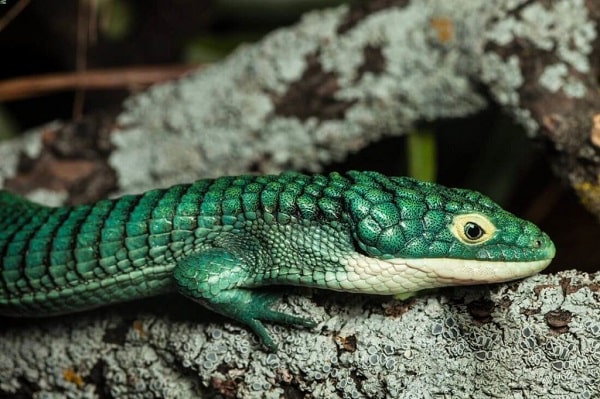
Most Abronia health issues are related to improper husbandry practices.
The most common issues are:
- Overheating
- Dehydration
- Stress
- Metabolic Bone Disease
These issues are easy to avoid by following the advice in our, and many other, care guides.
Behavior & Temperament
Abronia lizards are very curious and active once they’re accustomed to their surroundings.
Since they’re diurnal, they’re an excellent species for observing.
Misting and tong-feeding are great opportunities to interact with your pet, but it may take some months for them to become that comfortable with your presence.
They’re not afraid to bite when cornered or restrained, which is, in part, how they got their name.
A bite from a Mexican Alligator Lizard isn’t life-threatening, it typically doesn’t even require anything beyond basic first aid, but it’s certainly not pleasant – and will draw blood.
Handling
This species does better with a hands-off approach.
Since they’re so small, fast, and shy, they really aren’t suitable for frequent handling sessions.
Mexican Alligator Lizards do best as an observation-only species. All the more reason to make their habitat a gorgeous planted cloud forest oasis, housing live emerald jewels, as the centerpiece of the room!
Do Mexican Alligator Lizards Make Good Pets? A Summary
While this species is not an ideal choice for a casual beginner keeper, anyone who is ready to invest the time and funds required to learn about their native environment and create a perfect habitat is likely to succeed with the Mexican Alligator Lizard.
After you’ve conquered the complications of getting their enclosure set up correctly and given them time to recover from the stress of relocation, this is a relatively hardy species.
If you’re ready for a challenge and want the honor of caring for a real-life Jungle Gem, this just might be the species for you!
